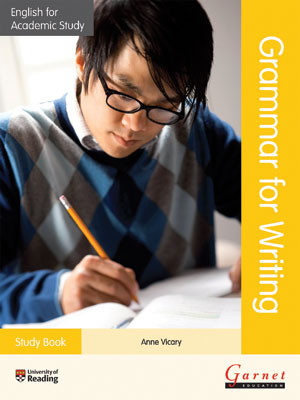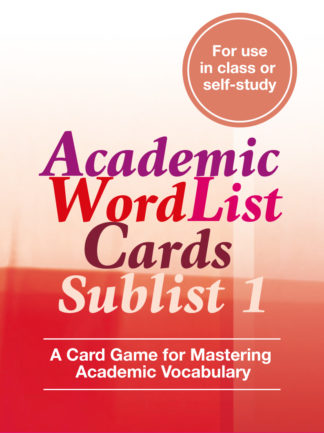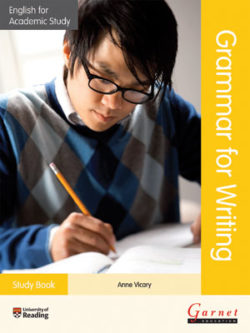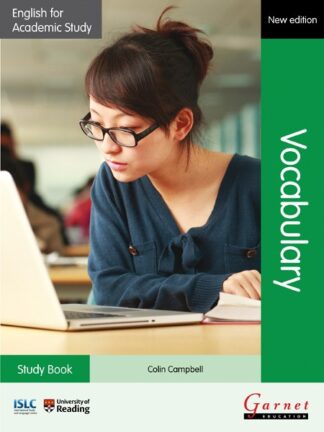Publisher: Garnet Education
Level: Intermediate to advanced CEF: B1 to C1 IELTS: 4.0 to 6.5
The best-sellingEnglish for Academic Study(EAS) series provides students with a clear and efficient path to academic competency and success. Students are no longer simply working through college-level materials; they are consciously developing skills and strategies that can transfer out of the EAP classroom into their future studies, becoming capable and autonomous learners.
EAS: Grammar for Writing: eschews rarely used but commonly taught grammatical items in favor of teaching students to use appropriate grammatical structures to express more complex academic ideas.
The book starts at a relatively low level, recognizing that many students require continuing practice of common grammatical problems in academic writing (such as subject-verb agreement, or the use of present simple and present continuous). It gradually increases the level of challenge so that by the end of the book students can use appropriate grammatical structures to express more complex academic ideas.
Each unit is divided into three stages, moving from basic structures to more complex ones. Full explanations and examples are followed by extensive practice exercises. Many exercises use examples from student essays, so students can identify typical problems and work out how to put them right. Each unit also includes an end-of-unit self-check test to give students a quick overview of what they have covered. There are four useful appendices on: articles, describing data, referring to academic sources, and a sample student essay.
The nine units are based on the following topics:
-
-
- Starting out
-
-
-
- Information flow within a text
-
-
-
- Looking back (past simple and present perfect)
-
-
-
- Showing logical links (1)
-
-
-
- Showing logical links (2)
-
-
-
- Expressing shades of meaning
-
-
-
- Expressing condition
-
-
-
- Avoiding person-based writing
-
-
-
- Using relative clauses
-
A full answer key is available on the English for Academic Study website at www.englishforacademicstudy.com. The dedicated website also provides additional resources across the range of titles in the series.
This book can be used in conjunction with the following books in the English for Academic Studies series.
Contents
i. Introduction
g. Glossary of grammatical terms
1. Starting out
2. Information flow within a text
3. Looking back
4. Showing logical links (1)
5. Showing logical links (2)
6. Expressing shades of meaning
7. Expressing condition
8. Avoiding person-based writing
9. Using relative clauses
a. Appendices
i. Index
Read more on the structure of EAS Grammar for Writing here.
Reviews
“Grammar for Writing is clearly laid out to enable a learner studying alone to grasp whatever is necessary. While Stages A and B in each unit expand on grammatical knowledge, Stage C extends and provides further practice plus an end-of-unit self-check test. Various aspects are colour coded: grammar explanations in blue boxes, further notes in purple. Apart from being clearly suitable for self-study, I began to think that I wouldn’t be at all upset if I was told I had to teach this book this semester. Take a look and see if you agree with me.”
– Wayne Trotman for EL Gazette
“…Grammar for Writing … is a welcome addition to Garnet’s list of published books for two principal reasons. The first is that there is considerable variety in the exercise types on offer which have direct relevance to the types of tasks a student of academic English is required to undertake whether for an exam or a course assignment. Secondly, the emphasis in this book is specifically on academic writing and the grammar needed for accurate and effective writing in academic contexts. Just as a budding guitarist finds that knowledge of a few pentatonic scales does not easily translate into Claptonesque type solos, so the New Zealand survey of EAP teachers (Barnard & Scampton, 2007) reported that the majority agreed that it was difficult for their students to transfer their grammatical knowledge into the production of authentic language. Grammar for Writing can help to bridge this gap and prove to be of benefit both to the independent learner and for occasional use in the classroom.”
– Martin White (University of Auckland) for The TESOLANZ Journal, Volume 22, 2014





